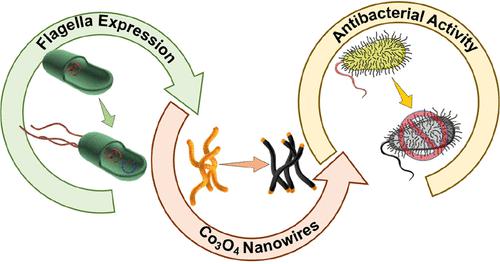当前位置:
X-MOL 学术
›
ACS Appl. Nano Mater.
›
论文详情
Our official English website, www.x-mol.net, welcomes your
feedback! (Note: you will need to create a separate account there.)
Bioengineered Bacterial Flagella-Templated in Situ Green Synthesis of Polycrystalline Co3O4 Nanowires for Gram-Negative Antibacterial Applications
ACS Applied Nano Materials ( IF 5.3 ) Pub Date : 2023-03-21 , DOI: 10.1021/acsanm.3c00146 Songyuan Yao 1 , Lin Wang 1 , Penghe Qiu 1 , Chuanbin Mao 1, 2
ACS Applied Nano Materials ( IF 5.3 ) Pub Date : 2023-03-21 , DOI: 10.1021/acsanm.3c00146 Songyuan Yao 1 , Lin Wang 1 , Penghe Qiu 1 , Chuanbin Mao 1, 2
Affiliation

|
In recent years, considerable progress has been made on the synthetic chemistry and antibacterial application of tricobalt tetroxide (Co3O4) nanomaterials. However, the current approaches to designing and synthesizing Co3O4 nanomaterials are complicated and hard to manipulate. Herein, we developed a one-pot strategy to synthesize Co3O4 nanowires at room temperature with an antibacterial activity. The synthesis process relied on the use of engineered bacterial flagella as a biotemplate, which were genetically modifiable protein nanofibers naturally attached to bacteria for assisting their swimming. We found that the flagella displaying negatively charged peptides (E10 and E20) effectively induced the nucleation of Co3O4 nanoparticles from a cobalt chloride (CoCl2) precursor solution on their surface to form polycrystalline nanowires, with the E20-flagella being more effective than the E10-flagella. However, the wildtype flagella or those displaying neutral (G10) or positively charged (K5) peptides did not effectively induce the Co3O4 nucleation on the flagella. A mechanism investigation discovered that an amorphous phase of Co3O4 was first formed rapidly on the E20-flagella, followed by a crystallization process with both the good crystallinity and nanowire water-dispersibility reached in 2 h. We also found that the E20-flagella formed the Co3O4 nanowires with the good crystallinity at a precursor solution of 1 mM. The E20-flagella-templated Co3O4 nanowires, synthesized using the optimal mineralization conditions (2 h and 1 mM CoCl2), showed the most effective killing of Gram-negative bacteria such as Escherichia coli. This work suggests that flagella with tunable peptide sequences are biotemplates for forming antibacterial nanowires at environmentally benign conditions.
中文翻译:

用于革兰氏阴性菌应用的多晶 Co3O4 纳米线的生物工程细菌鞭毛原位绿色合成
近年来,四氧化三钴(Co 3 O 4)纳米材料的合成化学和抗菌应用取得了长足的进展。然而,目前设计和合成Co 3 O 4纳米材料的方法复杂且难以操作。在此,我们开发了一种合成 Co 3 O 4的一锅法策略纳米线在室温下具有抗菌活性。合成过程依赖于使用工程细菌鞭毛作为生物模板,这是一种可遗传修饰的蛋白质纳米纤维,天然附着在细菌上以帮助它们游动。我们发现显示带负电荷的肽(E10 和 E20)的鞭毛有效地诱导 Co 3 O 4纳米颗粒从其表面的氯化钴(CoCl 2)前体溶液中成核以形成多晶纳米线,其中 E20 鞭毛更有效比 E10 鞭毛。然而,野生型鞭毛或显示中性 (G10) 或带正电 (K5) 肽的鞭毛不能有效诱导 Co 3 O 4在鞭毛上成核。机理研究发现,Co 3 O 4的无定形相首先在E20-鞭毛上快速形成,随后发生结晶过程,在2小时内达到良好的结晶度和纳米线水分散性。我们还发现E20-鞭毛在1mM的前驱体溶液中形成了具有良好结晶度的Co 3 O 4纳米线。使用最佳矿化条件(2 小时和 1 mM CoCl 2 )合成的以E20 鞭毛为模板的 Co 3 O 4纳米线显示出对大肠杆菌等革兰氏阴性菌的最有效杀灭. 这项工作表明,具有可调肽序列的鞭毛是在环境友好条件下形成抗菌纳米线的生物模板。
更新日期:2023-03-21
中文翻译:

用于革兰氏阴性菌应用的多晶 Co3O4 纳米线的生物工程细菌鞭毛原位绿色合成
近年来,四氧化三钴(Co 3 O 4)纳米材料的合成化学和抗菌应用取得了长足的进展。然而,目前设计和合成Co 3 O 4纳米材料的方法复杂且难以操作。在此,我们开发了一种合成 Co 3 O 4的一锅法策略纳米线在室温下具有抗菌活性。合成过程依赖于使用工程细菌鞭毛作为生物模板,这是一种可遗传修饰的蛋白质纳米纤维,天然附着在细菌上以帮助它们游动。我们发现显示带负电荷的肽(E10 和 E20)的鞭毛有效地诱导 Co 3 O 4纳米颗粒从其表面的氯化钴(CoCl 2)前体溶液中成核以形成多晶纳米线,其中 E20 鞭毛更有效比 E10 鞭毛。然而,野生型鞭毛或显示中性 (G10) 或带正电 (K5) 肽的鞭毛不能有效诱导 Co 3 O 4在鞭毛上成核。机理研究发现,Co 3 O 4的无定形相首先在E20-鞭毛上快速形成,随后发生结晶过程,在2小时内达到良好的结晶度和纳米线水分散性。我们还发现E20-鞭毛在1mM的前驱体溶液中形成了具有良好结晶度的Co 3 O 4纳米线。使用最佳矿化条件(2 小时和 1 mM CoCl 2 )合成的以E20 鞭毛为模板的 Co 3 O 4纳米线显示出对大肠杆菌等革兰氏阴性菌的最有效杀灭. 这项工作表明,具有可调肽序列的鞭毛是在环境友好条件下形成抗菌纳米线的生物模板。











































 京公网安备 11010802027423号
京公网安备 11010802027423号